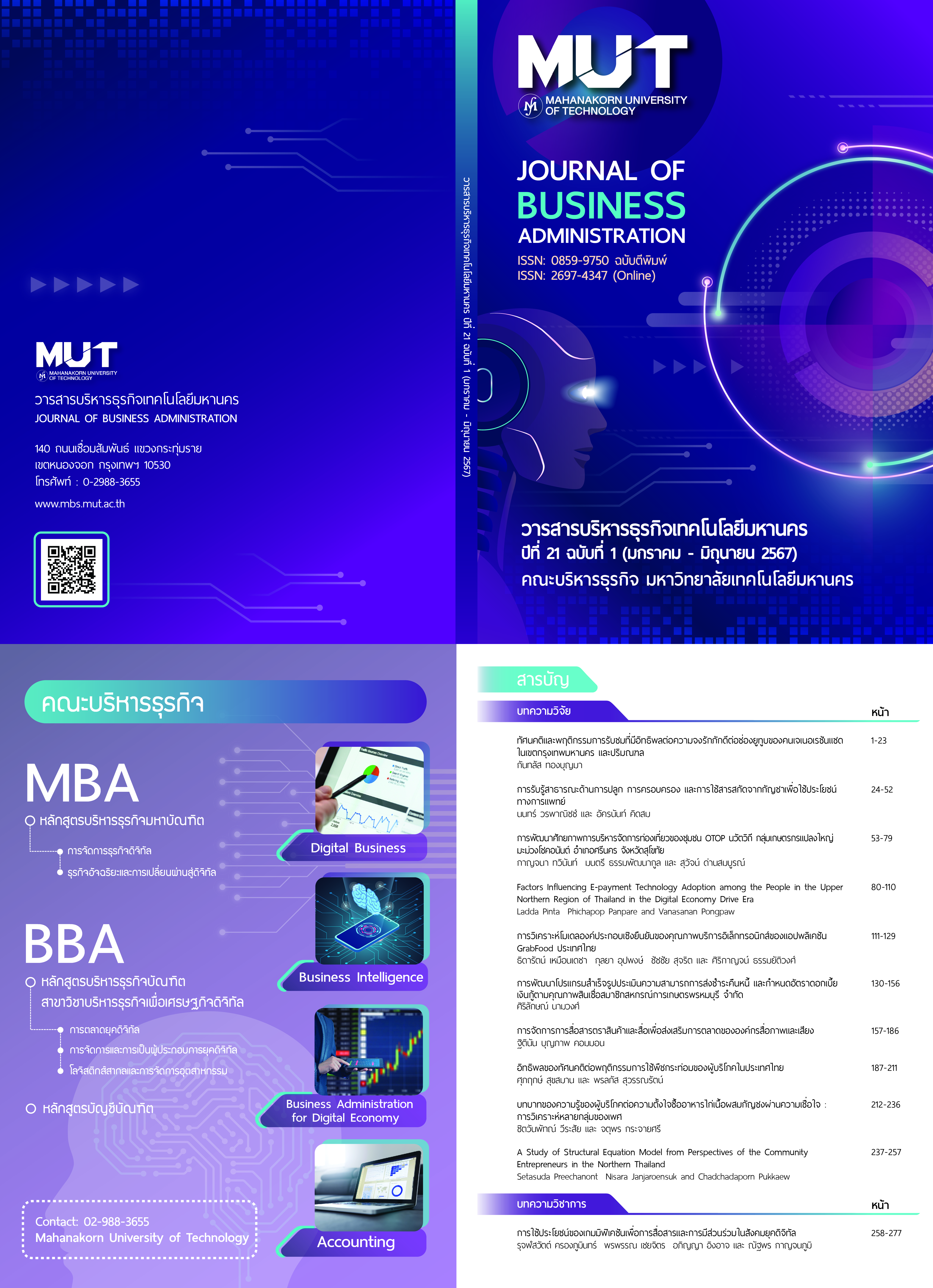A Study of Structural Equation Model from Perspectives of the Community Entrepreneurs in the Northern Thailand
Keywords:
Success Factors, Community Entrepreneurs, Northern Thailand, Structural Equation ModelAbstract
This article aimed at identifying the success factors needed by community entrepreneurship in the Northern Thailand using the Structural Equation Model (SEM).A questionnaire was used to collect data.Validity and reliability were conducted to test the instrument and modelling. A quantitative data analysis was accomplished using SEM. The collected data were analyzed using LISREL. The samplings of this study were the community entrepreneurship located in Chiang Mai, Chiang Rai, Lampang, Nan, Tak, and Phitsanulok provinces. Free parameter variables of this study, after the validity and reliability methods, were thirty-nine items. These thirty-nine parameters were calculated by ten times per each parameter, 390 samplings in total. The stratified sampling was used to find the number of collecting data from each province. The returned and cleaned data remained 358 samplings for analyzing the constructed model using SEM through LISREL software. The thorough research study indicated that the most important success factors of community entrepreneurs were accessibility of financial which related to supporting asset evaluation systems used for loan collateral and fair competition among financial service providers which benefit to community entrepreneur. Based on the results found from this work, the first hypothesis (i.e., the needs of supporting on accessibility to financial), as well as the success factors of community entrepreneur on administrational skill and education through supporting on accessible to financial had an influence on the success factors of community entrepreneurs (i.e., the third hypothesis). It means that the community entrepreneur should be able to access an asset evaluation systems of loan collateral with financial provide by service provider fairly and benefit to operate their business based on community entrepreneurs’ perspective in the Northern Thailand.
References
Al-Tit, A., Omri, A. and Euchi, J. 2019. Critical Success Factors of Small and Medium-Sized Enterprises in Saudi Arabia: Insights from Sustainability Perspective. Administrative Sciences. Vol. 9. No. 2. 32.
Awunyo-Vitor, D. and Sackey, R. A. 2018. Agricultural sector foreign direct investment and economic growth in Ghana. Journal of Innovation and Entrepreneurship. Vol. 7. No. 1.
Bentler, P. M. 1990. Comparative fit indexes in structural models. Psychological Bulletin. Vol. 107. No. 2. 238 - 246.
Bentler, P. M. and Bonett, D. G. 1980. Significance tests and goodness of fit in the analysis of covariance structures. Psychological Bulletin. Vol. 88. No. 3. 588 - 606.
Chueasraku, C. 2022. Factors in operations effecting the success on innovation of Community Enterprise of Wanyai District, Mukdahan Province. Social Sciences Research and Academic Journal. Vol. 17. No. 2. 63 - 72.
Dash, G., Kiefer, K. and Paul, J. 2021. Marketing-to-Millennials: Marketing 4.0, customer satisfaction and purchase intention. Journal of Business Research. Vol. 122. 608 - 620.
Hair, J. F. B., William C., Barry J. and Aderson, R. E. 2010. Multivariate Data Analysis. 7th Ed. New Jersey: Pearson Prentice Hall.
Hair, J. F. R., Christian, M. and Sarstedt, M. 2011. PLS-SEM: Indeed a Silver Bullet. Journal of Marketing Theory and Practice. Vol. 19. No. 2. 139 - 152.
He, H. and Harris, L. 2020. The impact of Covid-19 pandemic on corporate social responsibility and marketing philosophy. Journal of Business Research. Vol. 116. 176 - 182.
Hemaphan, P. 2022. The Success of OTOP Tourism Villages: Process and Institutional Entrepreneurship. Journal of Community Development and Life Quality. Vol. 10. No. 1. 22 - 34.
Hu, L. T. and Bentler, P. M. 1999. Cutoff criteria for fit indexes in covariance structure analysis: Conventional criteria versus new alternatives. Structural Equation Modeling. Vol. 6. No. 1. 1 - 55.
Intharajun, P. and Teeratansirikool, L. 2019. Key Success Factors of Entrepreneurs in Small and Medium Enterprise. Panyapiwat Journal. Vol. 11. No. 1. 289 - 303.
Jöreskog, K. G. and Sörbom, D. 1984. LISREL VI: Analysis of linear structural relationships by maximum likelihood, instrumental variables, and least squares methods. Scientific Software.
Jöreskog, K. G. and Sörbom, D. 2004. LISREL 8.7 for Windows. Lincolnwood. IL: Scientific Software International, Inc.
Kaewchuer, S., Phungniran, B. and Kortana, T. 2019. Factors for Success for Online Business Entrepreneurs in the Digital Age. The Journal of Industrial Technology. Vol. 19. No. 2. 33 - 44.
Kaewpakdee, P.; Urairat, Y. and Prommai, P. 2022. Potential Development of Agribusiness Enterpreneur in Songkhla Province. Economics and Business Administration Journal Thaksin University. Vol. 14. No. 1. 17 - 42.
Kerdumpang, P. 2023. The Influence of Innovative Leadership on the Competitive Ability of Startup Businesses in Nonthaburi Province. MUT Journal of Business Administration. Vol. 20. No. 2. 22 - 42.
Kline, R. B. 2016. Principles and Practice of Structural Equation Modeling. 4th Ed. London: Guilford Press.
Lam, L. W. 2012. Impact of competitiveness on salespeople's commitment and performance. Journal of Business Research. Vol. 65. No. 9. 1328 - 1334.
Mathuros, S. and Chansom, N. 2021. Successful Entrepreneur Factor of Small and Medium Business in the Central Region of Thailand. Journal of Business Administration The Association of Private Higher Education Institutions of Thailand. Vol. 10. No. 1. 84 - 102.
Rakshit, S., Islam, N., Mondal, S. and Paul, T. 2022. An integrated social network marketing metric for business-to-business SMEs. Journal of Business Research. Vol. 150. 73 - 88.
Raykov, T. and Marcoulides, G. A. 2006. A first course in structural equation modeling. 2nd Ed. Mahwah. NJ. US: Lawrence Erlbaum Associates Publishers.
Salim, A. M. and Abu Dabous, S. 2022. A review of critical success factors for solar home system implementation in public housing. International Journal of Energy Sector Management. Vol. 17. No. 5.
Snee, R. 1983. Regression Diagnostics: Identifying Influential Data and Sources of Collinearity. Journal of Quality Technology. Vol. 15. 149 - 153.
Srihirun, N. and Pongmakin, B. 2020. Management Factors Affecting the Key Success of Entrepreneurs of Small and Medium Enterprises in Chumphon Province. TNI Journal of Business Administration and Languages. Vol. 7. No. 1. 118 - 127.
Steiger, J. H. 1990. Structural model evaluation and modification: An interval estimation approach. Multivariate Behavioral Research. Vol. 25. No. 2. 173 - 180.
Taber, K. S. 2018. The Use of Cronbach’s Alpha When Developing and Reporting Research Instruments in Science Education. Research in Science Education. Vol. 48. No. 6. 1273 - 1296.
Vanichbuncha, K. 2022. Structural Equation Modeling (SEM) Analysis using AMOS. 5th Ed. Bangkok. Thailand: Samlada Limited Partnership.
Walker, E. and Brown, A. 2004. What Success Factors are Important to Small Business Owners? International Small Business Journal. Vol. 22. No. 6. 577 - 594.
Wangbenmad, C. and Bindulem, T. 2018. The Key Success Factors for Small and Medium Enterprises in Muang Hadyai, Songkha Province. Journal of Management Sciences Suratthani Rajabhat University. Vol. 1. No. 1. 109 - 124.
Additional Files
Published
Issue
Section
License

This work is licensed under a Creative Commons Attribution-NonCommercial-NoDerivatives 4.0 International License.
ข้อความ ข้อคิดเห็น ข้อมูล เนื้อหา รูปภาพ แผนภูมิ แผนผัง เป็นต้น ที่ปรากฏและแสดงในบทความต่างๆ ในวารสารบริหารธุรกิจเทคโนโลยีมหานคร ถือเป็นความรับผิดชอบโดยตรงของผู้เขียนบทความนั้นๆ มิใช่เป็นความรับผิดชอบใดๆ ของวารสารบริหารธุรกิจเทคโนโลยีมหานคร และมหาวิทยาลัยเทคโนโลยีมหานคร
บทความที่ตีพิมพ์ในวารสารบริหารธุรกิจเทคโนโลยีมหานคร ถือเป็นลิขสิทธิ์เฉพาะของคณะบริหารธุรกิจ มหาวิทยาลัยเทคโนโลยีมหานคร หากบุคคลหรือหน่วยงานใดต้องการนำทั้งหมดหรือส่วนใดส่วนหนึ่งไปเผยแพร่ต่อหรือเพื่อกระทำการใดๆ จะต้องได้รับการอนุญาตเป็นลายลักษณ์อักษรจากคณะบริหารธุรกิจ มหาวิทยาลัยเทคโนโลยีมหานครก่อนเท่านั้น


